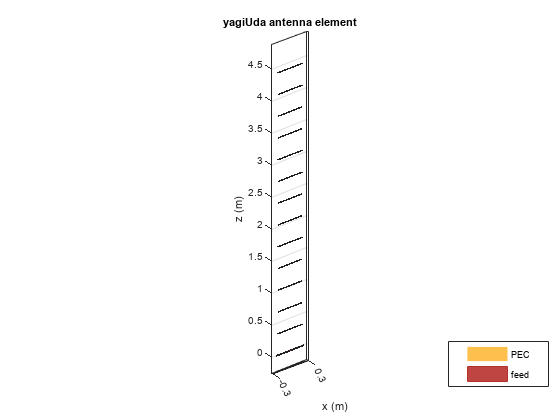yagiUda
Create Yagi-Uda array antenna
Description
The default yagiUda object creates a classic Yagi-Uda
array comprised of an exciter, reflector, and N- directors along the
z-axis resonating around 278 MHz. The reflector and directors
create a traveling wave structure that results in a directional radiation
pattern.
The exciter, reflector, and directors have equal widths and are related to the diameter of an equivalent cylindrical structure by the equation
where:
d is the diameter of equivalent cylinder
r is the radius of equivalent cylinder
For a given cylinder radius, use the cylinder2strip utility function to calculate the equivalent width. A
typical Yagi-Uda antenna array uses folded dipole as an exciter, due to its high
impedance. The Yagi-Uda is center-fed and the feed point coincides with the origin. In
place of a folded dipole, you can also use a planar dipole as an exciter.

Creation
Description
y = yagiUda
y = yagiUda(PropertyName=Value)PropertyName is the property name
and Value is the corresponding value. You can specify
several name-value arguments in any order as
PropertyName1=Value1,...,PropertyNameN=ValueN.
Properties that you do not specify, retain their default values.
For example, y = yagiUda(Exciter=dipole) creates an
Yagi-Uda antenna with a dipole exciter.
Properties
Object Functions
axialRatio | Calculate and plot axial ratio of antenna or array |
bandwidth | Calculate and plot absolute bandwidth of antenna or array |
beamwidth | Beamwidth of antenna |
charge | Charge distribution on antenna or array surface |
current | Current distribution on antenna or array surface |
design | Create antenna, array, or AI-based antenna resonating at specified frequency |
efficiency | Calculate and plot radiation efficiency of antenna or array |
EHfields | Electric and magnetic fields of antennas or embedded electric and magnetic fields of antenna element in arrays |
feedCurrent | Calculate current at feed for antenna or array |
impedance | Calculate and plot input impedance of antenna or scan impedance of array |
info | Display information about antenna, array, or platform |
memoryEstimate | Estimate memory required to solve antenna or array mesh |
mesh | Generate and view mesh for antennas, arrays, and custom shapes |
meshconfig | Change meshing mode of antenna, array, custom antenna, custom array, or custom geometry |
msiwrite | Write antenna or array analysis data to MSI planet file |
optimize | Optimize antenna and array catalog elements using SADEA or TR-SADEA algorithm |
pattern | Plot radiation pattern of antenna, array, or embedded element of array |
patternAzimuth | Azimuth plane radiation pattern of antenna or array |
patternElevation | Elevation plane radiation pattern of antenna or array |
peakRadiation | Calculate and mark maximum radiation points of antenna or array on radiation pattern |
rcs | Calculate and plot monostatic and bistatic radar cross section (RCS) of platform, antenna, or array |
resonantFrequency | Calculate and plot resonant frequency of antenna |
returnLoss | Calculate and plot return loss of antenna or scan return loss of array |
show | Display antenna, array structures, shapes, or platform |
sparameters | Calculate S-parameters for antenna or array |
stlwrite | Write mesh information to STL file |
vswr | Calculate and plot voltage standing wave ratio (VSWR) of antenna or array element |
Examples
References
[1] Balanis, C.A. Antenna Theory. Analysis and Design, 3rd Ed. New York: Wiley, 2005.
Version History
Introduced in R2015a
See Also
dipole | dipoleFolded | slot | cylinder2strip

